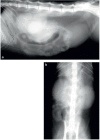Therapies for feline chronic kidney disease. What is the evidence?
- PMID: 19237135
- PMCID: PMC11132212
- DOI: 10.1016/j.jfms.2009.01.004
Therapies for feline chronic kidney disease. What is the evidence?
Abstract
Practical relevance Successful treatment and prevention of kidney disease in pet animals requires a multidimensional approach to identify and eliminate causes or exacerbating factors, provide professional examination and care on a regular basis, and plan and implement a comprehensive treatment program when necessary.
Evidence base Over the years, many therapeutic and preventive interventions have been developed or advocated for chronic kidney disease (CKD), but evidence of efficacy or effectiveness is often lacking or highly variable. Accordingly, the main objective of this systematic review was to identify and critically appraise the evidence supporting various approaches to managing feline CKD; namely, fluid therapy, calcitrioi therapy, antihypertensive therapy, ACE inhibitor therapy, erythropoietic hormone replacement therapy, potassium supplementation, antioxidant supplementation, alkalinization therapy, dietary phosphorus restriction and intestinal phosphate binders, therapeutic renal foods, assisted feeding, dialysis and renal transplantation.
Figures




References
-
- National Kidney Foundation. K/DOQT clinical practice guidelines for chronic kidney disease: Evaluation, classification, and stratification, IV. Definition and classification of stages of chronic renal failure. Am J Kidney Dis 2002; 39 (Suppl 1): S46–S75. - PubMed
-
- Polzin DJ, Osborne CA, Ross S. Chronic kidney disease. In: Ettinger SJ, Feldman EC, eds. Textbook of veterinary internal medicine. 6th edn. St Louis: Elsevier Saunders, 2005: 1756–85.
-
- Brown S. Evaluation of chronic renal disease: A staged approach. Compend Contin Edit Pract Vet 1999; 21: 752–63.
-
- International Renal Interest Society, http://www.iris-kidneycom (accessed May 27, 2008).
-
- Ross SJ, Polzin DJ, Osborne CA. Clinical progression of early chronic renal failure and implications for management. In: August JR, ed. Consultations in feline medicine, Volume 5. Philadelphia: Saunders Elsevier, 2006: 389–98.
Publication types
MeSH terms
Substances
LinkOut - more resources
Full Text Sources
Other Literature Sources
Medical
Miscellaneous

